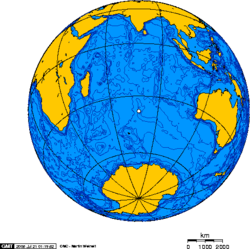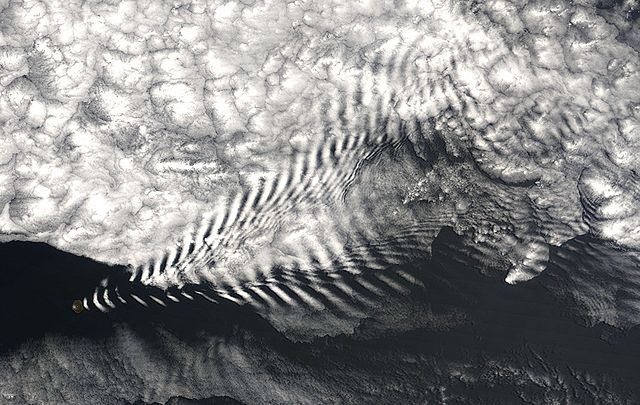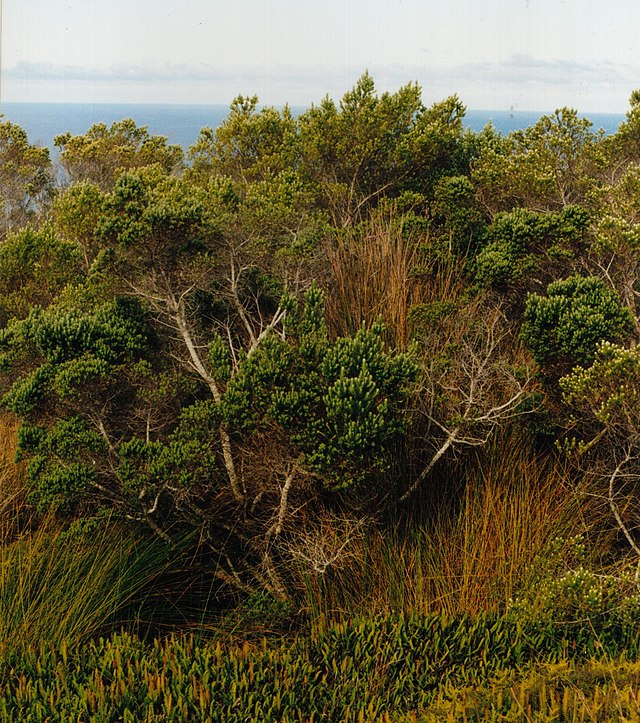Île Amsterdam
Island in the southern Indian Ocean From Wikipedia, the free encyclopedia
Île Amsterdam (French pronunciation: [ilamstɛʁdam]), also known as Amsterdam Island and New Amsterdam (Nouvelle-Amsterdam), is an island of the French Southern and Antarctic Lands in the southern Indian Ocean that together with neighbouring Île Saint-Paul 90 km (49 nautical miles) to the south forms one of the five districts of the territory.
Amsterdam Island (New Amsterdam) | |
|---|---|
|
Flag | |
| Motto: "Liberté, égalité, fraternité" | |
| Anthem: La Marseillaise | |
 Orthographic projection centred over Île Amsterdam. | |
| Status | District of French Southern and Antarctic Lands |
Nickname: Nouvelle Amsterdam | |
|---|---|
 The south, west, northwest and north coasts of Île Amsterdam. | |
 | |
| Geography | |
| Coordinates | 37°50′S 77°33′E |
| Area | 56.6 km2 (21.9 sq mi)[1] |
| Length | 10 km (6 mi) |
| Width | 7 km (4.3 mi) |
| Highest elevation | 867 m (2844 ft) |
| Highest point | Mont de la Dives |
| Administration | |
| Demographics | |
| Population | 28 |
The island is roughly equidistant to the land masses of Madagascar, Australia, and Antarctica – as well as the British Indian Ocean Territory and the Cocos (Keeling) Islands (about 3,200 km; 1,700 nautical miles from each). It is the northernmost volcanic island within the Antarctic Plate.[2]
The research station at Martin-de-Viviès, first called Camp Heurtin and then La Roche Godon, is the only settlement on the island and is the seasonal home to about thirty researchers and staff studying biology, meteorology, and geomagnetics.[3]
History
Summarize
Perspective

The first person known to have sighted the island was the Spanish explorer Juan Sebastián Elcano, on 18 March 1522, during his circumnavigation of the world. Elcano called it Desesperanza (Despair), because he couldn't find a safe place to land and his crew was desperate for water after 40 days of sailing from Timor. On 17 June 1633, Dutch colonial governor and mariner Anthonie van Diemen sighted the island, and named it after his ship, Nieuw Amsterdam.[4] The first recorded landing on the island occurred in December 1696, led by the Dutch explorer Willem de Vlamingh.[5]
French mariner Pierre François Péron wrote that he was marooned on the island between 1792 and 1795. Péron's Memoires, in which he describes his experiences, were published in a limited edition, now an expensive collectors' item.[6][7][8] However, Île Amsterdam and Île Saint-Paul were often confused at the time, and Péron may have been marooned on Saint-Paul.
Amsterdam and St. Paul islands were recommended in 1786 for a convict settlement by Alexander Dalrymple, the Examiner of Sea-Journals for the East India Company, when the British government was considering New South Wales and Norfolk Island for such a settlement.[9] An investigation of those islands was subsequently undertaken in December 1792 and January 1793 by George Lord Macartney, Britain's first ambassador to China, during his voyage to that country, who established that they were not suitable for settlement.[10]
Sealers are said to have landed on the island, for the first time, in 1789.[11] Between that date and 1876, 47 sealing vessels are recorded at the island, 9 of which were wrecked. Relics of the sealing era can still be found.[12]
The island was a stop on the British Macartney Embassy on its voyage to China in 1793.[13]
On 11 October 1833, the British barque Lady Munro was wrecked at the island. Of the 97 persons aboard, 21 survivors were picked up two weeks later by a US sealing schooner, General Jackson.[14]
John Balleny in command of the exploration and sealing vessel Eliza Scott (154 tons) visited the island in November 1838 in search of seals. He returned with a few fish and reported having seen the remains of a hut and the carcass of a whale.[15]
The islands of Île Amsterdam and Île Saint-Paul were first claimed by France in June 1843. A decree of 8 June 1843 mandated the Polish captain Adam Mieroslawski to take into possession and administer in the name of France both islands. The decree as well as the ship's log from the Olympe ship from 1 and 3 July 1843, stating that the islands had been taken into possession by Mieroslawski, are still preserved.[16][4]
However, the French government renounced its possession of the islands in 1853.[17]
In January 1871 an attempt to settle the island was made by a party led by Heurtin, a French resident of Réunion. After seven months, their attempts to raise cattle and grow crops were fruitless, and they returned to Réunion, abandoning the cattle on the island.[18]
In May 1880 HMS Raleigh circumnavigated the island searching for a missing ship the Knowsley Hall. A cutter and gig were despatched to the island to search for signs of habitation. There was a flagpole on Hoskin Point and 45–65 m (50–70 yards) north were two huts, one of which had an intact roof and contained three bunks, empty casks, an iron pot and the eggshells and feathers of sea-birds. There was also an upturned serviceable boat in the other hut, believed to belong to the fishermen who visited the island.[19]
In 1892, the crew of the French sloop Bourdonnais, followed by the ship L'Eure in 1893, again took possession of Saint-Paul and Amsterdam Island in the name of the French government.
The island was attached to the French colony of Madagascar from 21 November 1924 until 6 August 1955 when the French Southern and Antarctic Lands was formed. (Madagascar gained independence in 1958.)
The first French base on Île Amsterdam was established in 1949, and was originally called Camp Heurtin. It is now the Martin-de-Viviès research station, named after Paul de Martin de Viviès who, with twenty-three others, spent the winter of 1949 on the island. The station was originally named Camp Heurtin and has been in operation since 1 January 1981, superseding the first station, La Roche Godon.[3]
The Global Atmosphere Watch still maintains a presence on Île Amsterdam.
On 15 January 2025, a wildfire broke out in the island, forcing the evacuation of all 31 residents by boat to Réunion. Due to the island's remote location, the fire spread unchecked. By 10 February, 45% of the island's area had been affected, while water supply and telecommunications infrastructure at the Martin-de-Viviès research station was damaged.[20]
Amateur radio
From 1987 to 1998, there were frequent amateur radio operations from Amsterdam Island. There was a resident radio amateur operator in the 1950s, using callsign FB8ZZ.[21]
In January 2014 Clublog listed Amsterdam and St Paul Islands as the seventh most-wanted DXCC entity.[22] On 25 January 2014 a DX-pedition landed on Amsterdam Island using MV Braveheart and began amateur radio operations from two separate locations using callsign FT5ZM. The DX-pedition remained active until 12 February and achieved over 170,000 two-way contacts with amateur radio stations worldwide.
Environment
Summarize
Perspective

Geography
The island is a potentially active volcano.[2] It has an area of 56.6 km2 (21.9 sq mi),[1] measuring about 10 km (6 mi) on its longest side, and reaches as high as 867 m (2,844 ft) at the Mont de la Dives. The high central area of the island, at an elevation of over 500 metres (1,600 ft), containing its peaks and caldera, is known as the Plateau des Tourbières (Plateau of Bogs). The cliffs that characterise the western coastline of the island, rising to over 700 metres (2,300 ft), are known as the Falaises d'Entrecasteaux after the 18th-century French navigator Antoine Bruni d'Entrecasteaux.[23]
Geology
No historical eruptions are known, although the fresh morphology of the latest volcanism at Dumas Craters on the NE flank suggests it may have occurred as recently as the late 19th century.[2][24] All the rocks are tholeiitic basalt and the oldest basalt sampled is no more than 720,000 years old.[25]: 181
There are two stratovolcanoes being Mont De La Dives which dominates and is younger and Le Mount du Fernand. Vents manifest as either cones or craters include Cratere Antonelli, Le Brulot, Le Chaudron, Le Cyclope, Crateres Dumas, Le Forneau, Cratere Inferieur, Grande Marmite, Cratere Hebert, Museau De Tanche, Cratere de l'Olympe, Cratere Superieur, Crateres Venus, and Cratere Vulcain (see map on this page).[2]
The island is located on the mainly undersea Amsterdam–Saint Paul Plateau which is of volcanic hotspot origin.[26]: 128 There is a magma chamber located at between 20–36 km (12–22 mi) depth below Amsterdam Island.[27] The plateau which extends north west towards the Nieuw Amsterdam Fracture Zone (Amsterdam Fracture Zone) and south to beyond the island of St Paul with its presently known active area being delimited by the St. Paul Fracture Zone,[28] is a 250 by 200 km (160 by 120 mi) feature of the sea floor near the Southeast Indian Ridge, which is an active spreading center between the Antarctic plate that the island lies on, and the Australian Plate.[25]: 180 Helium isotopic compositional studies are consistent with its formation from the combined effects of accretion at the mid-ocean ridge ridge and mantle plume activity of a hot spot.[25]: 180 This is either the Kerguelen hotspot or a potentially separate Amsterdam-Saint Paul hotspot but resolution of this issue is complicated by the recent volcanism on the island due to it being adjacent to the Southeast Indian Ridge.[29]: 1177 [30]: 128 Recent authors have favoured a separate Amsterdam and St. Paul hotspot.[28] There has been evidence at Boomerang Seamount to the north east of the island that Kerguelen-type source mantle exists beneath the Amsterdam and St. Paul Plateau.[31]: 257 Which ever hot spot is responsible is moving south as Île Amsterdam rocks are older than St. Paul rocks.[25]: 181 The Amsterdam–St. Paul Plateau while formed in the last 10 million years, started this formation beneath the Australian Plate so the island is built on the components of two tectonic plates.[32]
Climate
Île Amsterdam has a mild, oceanic climate, Cfb under the Köppen climate classification, with a mean annual temperature of 14 °C (57.2 °F), annual rainfall of 1,100 mm (43 in), persistent westerly winds and high levels of humidity.[33] Under the Trewartha climate classification the island is well inside the maritime subtropical zone due to its very low diurnal temperature variation keeping means high.
| Climate data for Amsterdam Island (Martin-de-Vivies, 1991−2020 normals, extremes 1950–present) | |||||||||||||
|---|---|---|---|---|---|---|---|---|---|---|---|---|---|
| Month | Jan | Feb | Mar | Apr | May | Jun | Jul | Aug | Sep | Oct | Nov | Dec | Year |
| Record high °C (°F) | 26.1 (79.0) |
26.2 (79.2) |
24.8 (76.6) |
23.4 (74.1) |
21.0 (69.8) |
20.3 (68.5) |
18.2 (64.8) |
17.7 (63.9) |
23.9 (75.0) |
19.2 (66.6) |
22.4 (72.3) |
24.8 (76.6) |
26.2 (79.2) |
| Mean daily maximum °C (°F) | 20.6 (69.1) |
20.9 (69.6) |
20.0 (68.0) |
18.1 (64.6) |
16.2 (61.2) |
14.6 (58.3) |
13.8 (56.8) |
13.6 (56.5) |
14.3 (57.7) |
15.0 (59.0) |
16.6 (61.9) |
19.0 (66.2) |
16.9 (62.4) |
| Daily mean °C (°F) | 17.6 (63.7) |
17.9 (64.2) |
17.2 (63.0) |
15.7 (60.3) |
13.8 (56.8) |
12.3 (54.1) |
11.5 (52.7) |
11.3 (52.3) |
11.9 (53.4) |
12.5 (54.5) |
14.0 (57.2) |
16.1 (61.0) |
14.3 (57.7) |
| Mean daily minimum °C (°F) | 14.5 (58.1) |
15.0 (59.0) |
14.5 (58.1) |
13.2 (55.8) |
11.5 (52.7) |
10.1 (50.2) |
9.2 (48.6) |
8.9 (48.0) |
9.5 (49.1) |
10.0 (50.0) |
11.3 (52.3) |
13.2 (55.8) |
11.7 (53.1) |
| Record low °C (°F) | 6.1 (43.0) |
4.5 (40.1) |
6.0 (42.8) |
4.3 (39.7) |
3.8 (38.8) |
3.0 (37.4) |
1.8 (35.2) |
1.9 (35.4) |
2.1 (35.8) |
3.1 (37.6) |
4.7 (40.5) |
1.7 (35.1) |
1.7 (35.1) |
| Average precipitation mm (inches) | 68.3 (2.69) |
62.7 (2.47) |
100.0 (3.94) |
93.3 (3.67) |
121.5 (4.78) |
114.8 (4.52) |
112.1 (4.41) |
87.8 (3.46) |
74.8 (2.94) |
75.7 (2.98) |
77.0 (3.03) |
70.0 (2.76) |
1,058 (41.65) |
| Average precipitation days (≥ 1.0 mm) | 9.3 | 9.1 | 11.1 | 12.4 | 16.8 | 17.9 | 18.3 | 16.9 | 14.7 | 13.8 | 11.7 | 10.1 | 161.9 |
| Average dew point °C (°F) | 13 (55) |
13 (55) |
13 (55) |
11 (52) |
10 (50) |
8 (46) |
8 (46) |
7 (45) |
6 (43) |
7 (45) |
9 (48) |
11 (52) |
10 (49) |
| Mean monthly sunshine hours | 177 | 145 | 134 | 110 | 107 | 99 | 104 | 121 | 123 | 141 | 150 | 170 | 1,581 |
| Source 1: Météo France[34] | |||||||||||||
| Source 2: NOAA (sun 1961–1990),[35] Meteo Climat (record highs and lows)[36] Time and Date (dewpoints 2005–2015)[37] | |||||||||||||
Flora and fauna

Vegetation
Phylica arborea trees occur on Amsterdam, which is the only place where they form a low forest, although the trees are also found on Tristan da Cunha and Gough Island. It was called the Grand Bois ("Great Forest"), which covered the lowlands of the island until forest fires set by sealers cleared much of it in 1825. Only eight fragments remain. Sailors from HMS Raleigh, who visited the island on 27 May 1880, described the vegetation as:
"Rough ground, grass several feet high, myrtle 10–15 feet [3–5 m] high in sheltered ravines, sedge, ferns (principally polypodium) and cabbages, grown into bushes with stumps several inches thick in the garden..."[19]
Birds

The island is home to the endemic Amsterdam albatross, which breeds only on the Plateau des Tourbières. Other rare species are the brown skua, Antarctic tern and western rockhopper penguin. The Amsterdam duck is now extinct, as are the local breeding populations of several petrels. There was once possibly a species of rail inhabiting the island, as a specimen was taken in the 1790s (which has been lost), but this was either extinct by 1800 or was a straggler of an extant species.[38] The common waxbill has been introduced.[39] Both the Plateau des Tourbières and Falaises d'Entrecasteaux have been identified as Important Bird Areas by BirdLife International, the latter for its large breeding colony of Indian yellow-nosed albatrosses.[23]
Mammals
There are no native land mammals. Subantarctic fur seals and southern elephant seals breed on the island. Introduced mammals include the house mouse, brown rat and feral cats.[39] An eradication campaign of these invasive species was started in 2023, which plans to eradicate all cats and rats from the island by late 2024.[40]
A distinct breed of wild cattle, Amsterdam Island cattle, also inhabited the island from 1871 to 2010. They originated from the introduction of five animals by Heurtin during his brief attempt at settlement of the island in 1871[39] and by 1988 had increased to an estimated 2,000. Following recognition that the cattle were damaging the island ecosystems, a fence was built restricting them to the northern part of the island.[38] In 2007 it was decided to eradicate the population of cattle entirely, resulting in the slaughter of the cattle between 2008 and 2010.[41]
See also
References
Further reading
External links
Wikiwand - on
Seamless Wikipedia browsing. On steroids.


